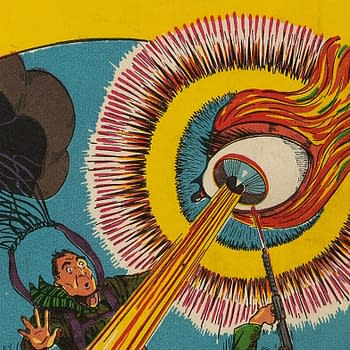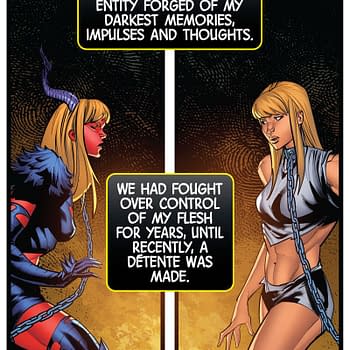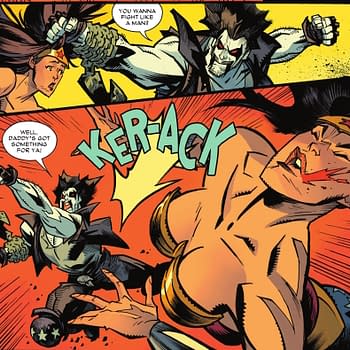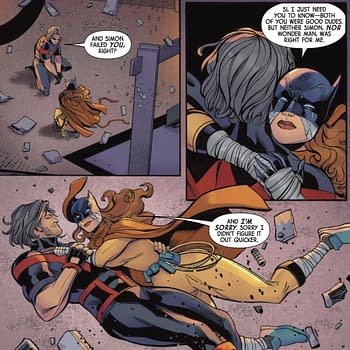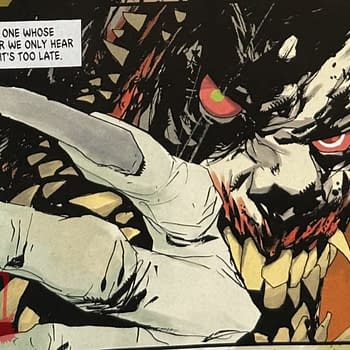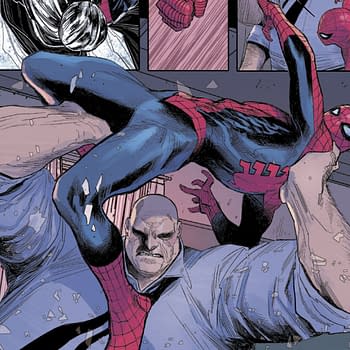Posted in: Comics, Recent Updates | Tagged: ComiXology Submit, David Steinberger, indie Comics, joe infurnari, John Roberts, Joshua Hale Fialkov, new york comic con, the bunker
Getting the Nitty Gritty on ComiXology Submit at New York Comic Con
On March 6, 2013, ComiXology launched the "Submit" program, enabling comics creators to upload their own comics for review to be sold on the ComiXology platform. Creators such as Becky Cloonan piloted some of the first comics through the program, and creators came forward to share their experiences. Since then, there are weekly updates of newly added comics and at New York Comic Con, the future of Submit will be explored further as it rounds the bend on over 6 months in use…
Discussions in the audience as the panel begins seem to suggest that there are plenty of indie creators attending, and they feel frustrated by the inability to reach a wider audience, whether through press releases or social media. They wonder if Submit would give them the boost they need toward bigger readership. In recent articles I've done, several artists and writers who are currently launching successful Kickstarters are doing so because they grew a fanbase through Submit first, and are using the two strategies in conjunction, so this seems to be the decision indie creators are facing-do they take on multiple approaches at the same time to launch their comics. Submit may be the answer, particularly when combined with other platforms.
John D. Roberts introduced the panel, with David Steinberger, Joshua Hale Fialkov, and Joe Infurnari (the latter are are the creators of The Bunker, currently on ComiXology via Submit).

Walking Dead Season 4 starts Sunday, and there's a big sale on Walking Dead comics on ComiXology right now, and the new DC content. Avatar too. Some of the comics are available only on the website because "rougher" than iTunes like the deal with. Today they launched Ape Entertainment. ComiXology are giving away art cards during the con and free downloads of The Bunker issue #1.
John D. Roberts asked how many creators and small publishers were present, and most of the room raised their hand. He described Submit as launched in March 2013, and the process being "quick and easy" after upload. Strong PDF files are necessary for approval before joining the scheduling cue.
Roberts then played a video for the Submit program describing the process. He also informed the audience that since launching in March, Submit has become the 10th largest publisher on ComiXology with 330 new series with new ones launching every Wednesday.
Roberts addressed Fialkov and Infurnari's The Bunker as an example of a Submit project. It was a digital first comic that premiered through Submit.
Fialkov described the Bunker as a book about a group of college kids who bury a time capsule, and while digging discover a bunker with material from the future that shows their own part in the coming apocalypse. The first issue got into the top 10 sellers on ComiXology. He and Joe have been working with publishers and self-publishing for a long time, and Submit is a great way to avoid "jumping through hoops".
Fialkov did a comic called Elk's Run previously, and the Eisner-Nominated Tumor, and work for DC and Marvel while Infurnari got his start through web comics, including the Eisner-Nominated The Process. He's worked with Oni and First Second. This is his first foray into ComiXology.
Fialkov worked with digital first comics at DC previously. He likes the "sheer joy" of the reading experience on a tablet and thereafter wanted to go digital with his works.
Infurnari feels that the time frame on comics creation, up to 2 years, can be truncated toward "instant gratification" and get things "rolling" in a "very easy" way, like with The Bunker.
Steinberger asked Fialkov and Infurnari if they created The Bunker in landscape format for digital and they affirm that. It's a common conversation, Fialkov says, to determine format, but Infurnari doesn't want the format to be an impediment to reading.
Roberts spoke about avoiding printing costs for indie creators and the "timely fashion" of distribution on Submit. "We can make the comics and we can be live when we do it", says Fialkov. He can "cater what he's doing to fans" and Infurnari described a flood of tweets on the first day of publishing for The Bunker and a lot of "positive reinforcement".
Steinberger brought up printing again, and asked if The Bunker was sketched out in pages. Fialkov feels the "greatest tool" of comics is the "page turn" as an "ultimate form of control". In a digital comic, there is the same "power" but writing or drawing "both ways" is very difficult, and harder to make effective. Restacking the pages can be done, but for Fialkov the book will always read better in the landscape format.
Roberts then opened up the panel to questions.
Q: Is ComiXology always in a landscape format?
Roberts: No, and I'll show you an example of Becky Cloonan's award-winning The Mire.
Roberts then showed slides of The Mire as a "traditional comic" in format as an example.
Roberts: There isn't a "set standard" in format for the Submit portal. ComiXology's "bread and butter" is digital formats of print comics, but a lot of creators are starting to create with digital in mind first. Most likely the only experience a reader may have of your content may be digitally for indie creators. It's very important to think about the reader. The harder it is for the reader, the less likely they are to come back.
Steinberger: Did you all have to think a lot about font-size and test it out?
Infurnari: Sadly, we didn't. I've done web comics so I'm familiar with DPI images and picked that up as a guide for font. Some readers wrote in saying there was a font they had difficulty reading, so we adjusted.
Roberts: One of the benefits of digital is that you can fix things.
Infurnari: I read on my iPhone and can scale up images.
Q: Do you have plans to promote Submit? They are very hard to find on the site, "in the basement". Will there be more marketing and more on the site?
Steinberger: Yes. Submit books make it into the main page every week, and IGN has been reviewing extensively. Point taken. Obviously, it needs work. We don't think of it as being "in the basement" since the best stuff will float to the top.
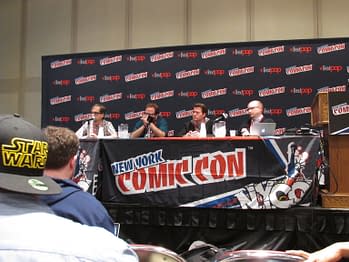
Q: The name "ComiXology Submit" seems hampered on the website (to find).
Q: As a not yet published writer, I appreciate the speed at which ComiXology works, but I prefer to read print and when I'm writing, I'm thinking in terms of print…and yet I don't think there's anything lost in translation (to digital). How do you think in terms of guided view? If this gets put in print, how do we not alienate the people who read it digitally first?
Fialkov: It's a juggling act. And it is harder because you're doing two things at once. My advice would be to start by doing a regular-sized comic.
While digital-first is somewhat new, the kind of process we're going through, this is the future. This is how things are going to be. The floppy comic model is becoming unfeasible. It's really hard to make money. When I ran a small press, I only made money through relationships and knowing publishers. Now you don't have to worry about that stuff. The way I look at it, the great part for brick and mortar retailers, they are selling something that costs 20 dollars with an audience vs. a risk on something that costs 3 dollars. Don't be scared. I guarantee that through your career, you're going to see much less print and much more digital.
Roberts: I noticed this "happy accident" that old comics could easily be cut from the old Marvel style in the 70's and 80's to this format.
Q: Could you unpack what you do when you review?
Roberts: What is our review process? Bad PDF files are a huge issue. We've started putting up a guide, to avoid a stained-glass effect that's caused by too much compression. You have to change the settings in Acrobat Pro, for instance. We're looking for professional level quality. We've pushed back on books that use Comic Sands as font. We had a book come in, a classic Marvel homage, and Sands brought the quality down. I advised them to change the font via Blambot. It looked a million times better.
We're looking for good production quality, no blue lines.
There are two websites: Comic Craft, with free fonts, but a good font is worth it. The website Comicbookfonts.com. Blambot has a couple of free fonts being used in the industry.
Fialkov: The number one problem on new books is that they don't hire a letterer, least expensive, but most important. Your pro-tip for the day is hire a professional letterer.
Q: What about genres of comics you are looking for? Do you frown upon certain genres? Superhero comics or kids comics?
Steinberger: We don't care. What's important to us is good storytelling. We even have different styles, from sloppy and sketchy to very tightly rendered. The beauty of digital comics is that you can skew outside the adolescent male reader into things like school romance. We can. It doesn't cost us anything more to put the next one out. I encourage you to tell the story that you want to tell. My hope is that in the next few years we become very good at matching up the right consumer to the right product. Like France, where everyone reads comics from every age group, gender etc. Submit what you want to make.
Q: Do indies who work for you submit to ComiXology exclusively or on other websites, too?
Roberts: Rights? You can go everywhere you want. It's a non-exclusive agreement. You can put comics on your website, amazon. You're free to do whatever you want with it. If you want to get it published, you don't even have to talk to us. You can just go ahead and do it.
Q: Does the 90's style of breaking panels and mushing up scenes work in guided view? These guys, for instance, didn't make a guided view comic, but a comic, and it can be read either way. 80% of our users think it's important. People love it. It's a compromise though, on a print book. Our digital editors spend a lot of time trying to make it the best reading experience possible, but as we go more digital, there are going to be more people working within panels. We also have some nice cinematic techniques to handle guided view with pull-backs and such. We do our best. You guys have a clean panel layout.
Infurnari: Yes, it is. I did a book Marathon with less borders etc. With guided view I tried to keep within panels. But in my experience, it's been an impediment to have art flood over panel borders.
Fialkov: Working at Marvel, it's something that comes out, working with two page spreads. No one at Marvel said "you can no longer do 2 page spreads" but we're all aware of it, and you start to change your techniques. The traditional Bendis page of 2 page spreads with 20-30 panels don't read as well. Splash pages increase with minimal lettering.
Steinberger: Our manager is production is here, and we have a whole team thinking about these things. Asking how the reader will feel if they get a caption that's a quip that pulls back to an enormous scene, which can be thrilling.
Q: Thank you for opening up to the little guy. I'm glad to hear that you're profiting from it. I've been through the Submit process and accepted, and thank you. Do the digital editors become almost counsellors? Is it a back and forth, so we can help you?
Steinberger: If you're making a guided view native book, yes. We're actually behind in the production process because of the number of books we've accepted. It's not abnormal to be accepted but not out yet. There are some communication channels within submit. We won't do several revisions within guided view so that you can get your next book out unless it's a guided view native.
Q: Is there a minimum number of pages or issues that you'll carry?
Roberts: People tend to do 8 pages at least, but we don't have a rule. One of the benefits of distributing digitally is that you can do an odd number of pages if you want. The minimum price we can charge is 99 cents so we try to make sure the amount of content is worth that money.
Bleeding Cool's Jeremy Konrad: Do you ever worry about having to censor a creator before it goes live?
Steinberger: For any content we're not sure about, we submit to Apple and see if they want to sell it. If we think it's a good story, and not sadistic…We just launched Avatar, you guys. We have an adult category. We have some very edgy, highly sexual, violent comics. We try not to be the censor of content. We take it on an as you come basis.
Q: Who sets the prices? How do the cuts of that work?
Roberts: You do. The contract is a 50-50 split after costs. If we sell it on the web, there's less of a channel cost. If you sell through our site, you make the most money. Less through Apple.
Q: Have you tried a "pay what you want" model?
Steinberger: There's no such thing on app stores. The payment platforms don't work. It's the same with "pay what you want". There are no options for those platforms. Other people are experimenting with that. If everything goes great, it's something we'll look at, but then it would have to be web only. We are everywhere, and it's important we have the same content on different platforms.
Fialkov commented that you have to educate people about who you are to make money in comics. The advice at the end of the day is to make comics, don't worry about whether you are going to make money at first. Worry about being as good as you can be.
Steinberger: You have to be the person who loves it enough to do it, and most people have put in years of work before they "hit it". If you want to make comics, just make them.
Fialkov: What always comes to the forefront for me when I talk to other creators is about how to get more comics out there. And you don't see that other places, in other forms.
Q: Once you're accepted and you're live on ComiXology, what happens then?
Roberts: The process now is that one week prior to release you get some information including a URL to use for promotional purposes. I encourage retweeting. You get paid quarterly, net 45. 45 days after the quarter, and there's a threshold, but you should get a report that shows how much you've sold in that period.
Steinberger: There's no daily control panel with updates…yet!
Q: Are we allowed to have two versions of the same book to give people options?
Fialkov: You're not really giving them options at that point. The problem with "pay as you go" is, and we've talked to people, is that you're giving it away for free. You're devaluing your own product. If you think your book is worth a dollar, or two, or three, then charge that much!
[Applause from audience]
Steinberger: We were told that 99 cents was the magic price point, but Robert Kirkman said, "Naw man, my books are worth 1.99". And he was right. Higher prices enable us to have sales. Value your own work.
Q: Could you include a charity donation in your comic price?
Steinberger: We have done deals with creators who have donated their profits to charity, but it's not something we build a lot of tech around. We've done a CBLDF comic and a couple other things. It's on a one off basis.
Steinberger: We have codes to create give aways if you want.
Fialkov: You can give it away yourself. To some degree, ComiXology is a distributor and marketing falls on you. You are an independent creator, and have to do things yourself.
Q: Do you have a "wait and see" approach for a single issue to see audience reaction?
Roberts: We've seen people do that. Doing experiments to see how they would continue. But I think if you want to make comics, make comics. If you are looking to do this to make money, wrong industry.
Steinberger: Did you all have guidelines on profit?
Fialkov: We did this book regardless of profits. We wanted to hang out together.
The panel Q and A was one of the liveliest I've ever witnessed at a comic con outside of a Big Two big announcement panel, and the questions were insistent and curious, guarded and optimistic, by turn. Creators are clearly weighing their options when it comes to the Submit platform, and while they are finding plenty to interest them, their concerns seem to be with formatting, and the degree of control they continue to exercise over the reading experience they are providing by launching on ComiXology. It's a crucial period of decision for indie creators, between digital and print, between webcomics and personal distribution, but Submit seems to have a great deal of flexibility that can continue to provide new answers as new questions are raised, many of which they are still exploring themselves.
Hannah Means-Shannon is Senior New York Correspondent at Bleeding Cool, writes and blogs about comics for TRIP CITY and Sequart.org, and is currently working on books about Neil Gaiman and Alan Moore for Sequart. She is @hannahmenzies on Twitter and hannahmenziesblog on WordPress. Find her bio here.










